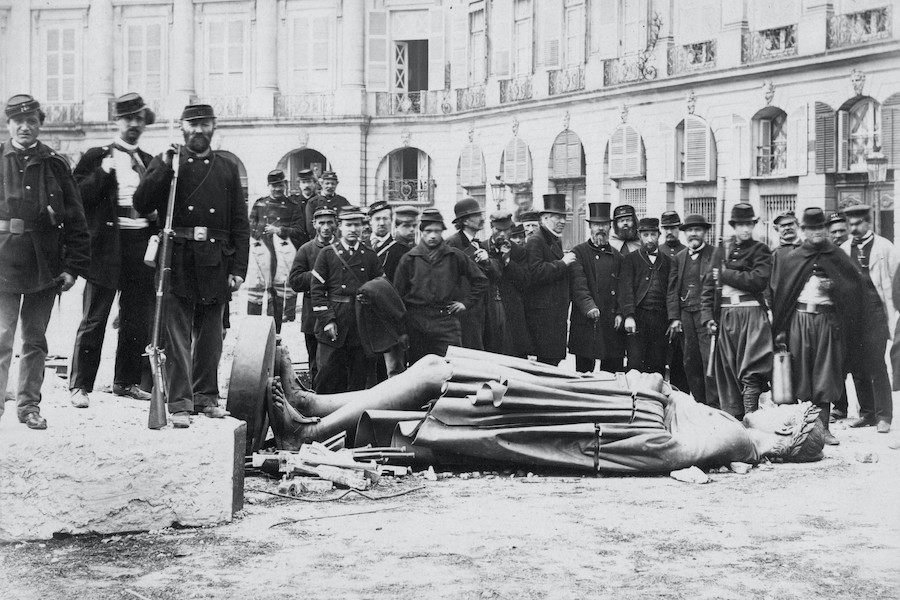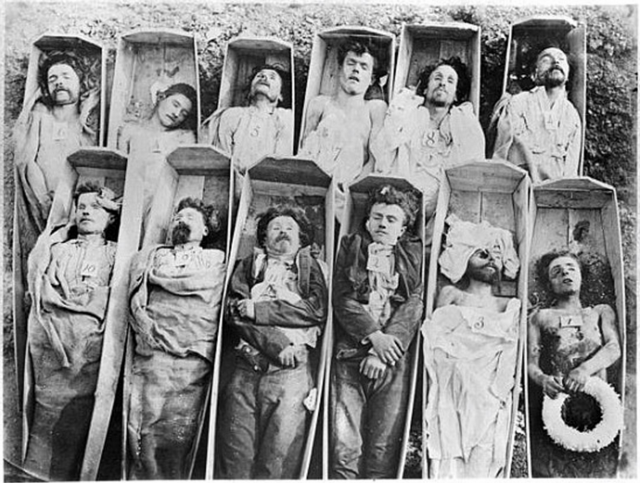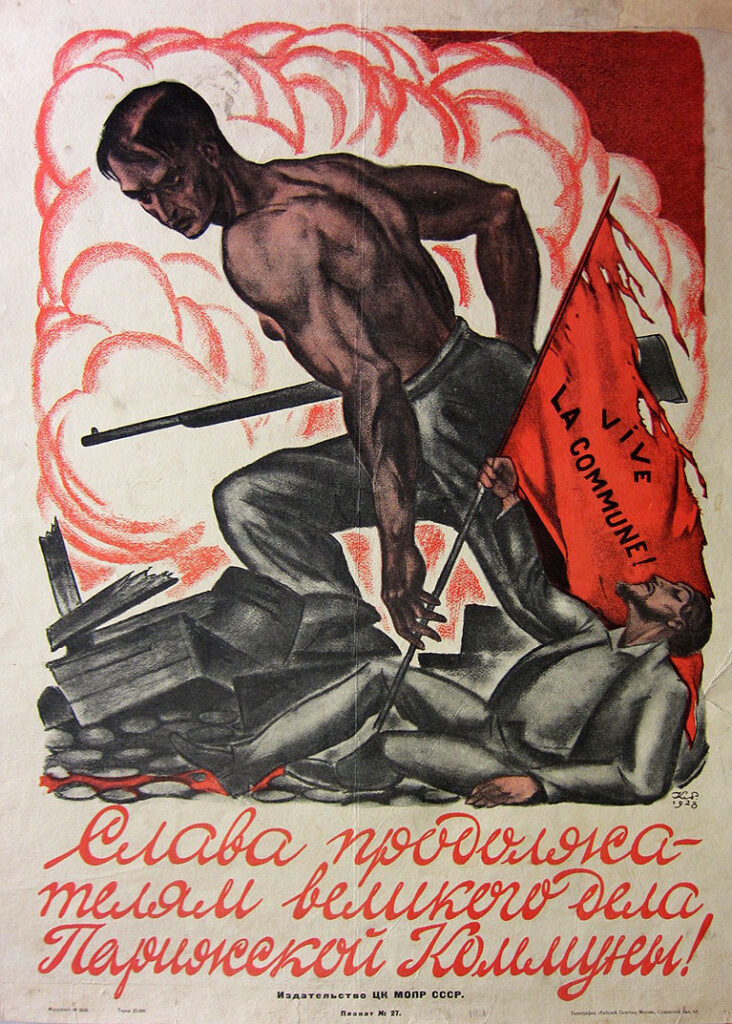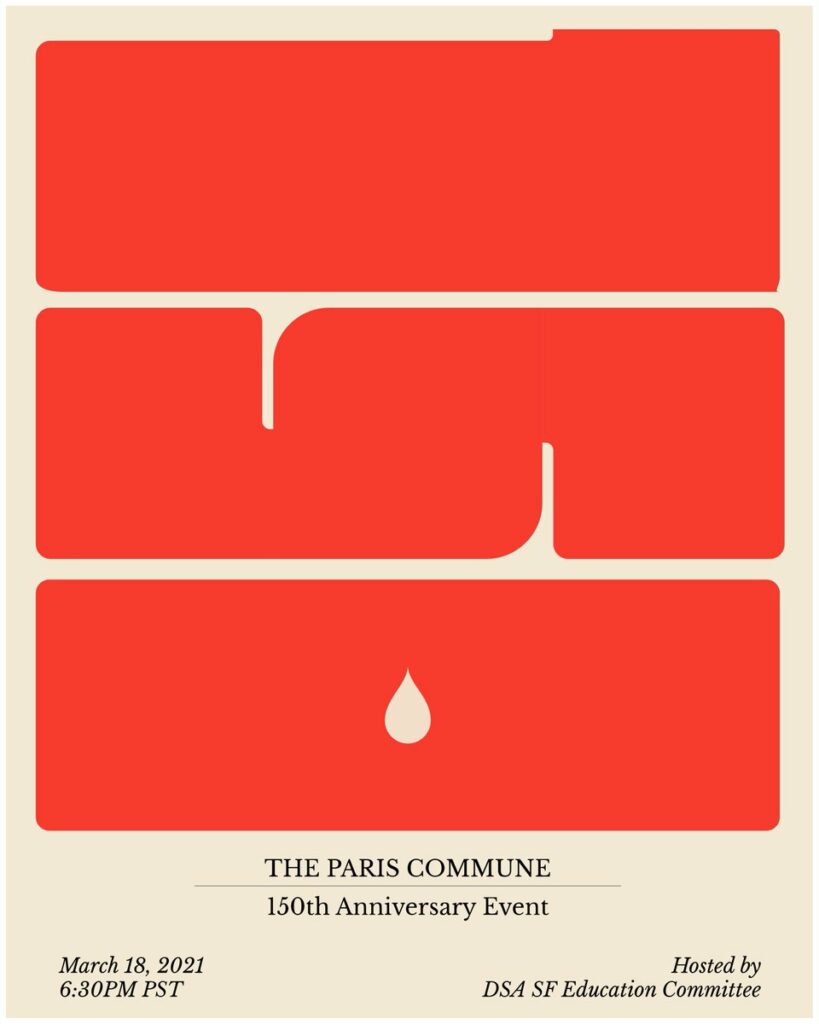The Paris Commune rose and fell in the spring of 1871. Its echoes still resonate today, 150 years later. For 72 days, ordinary people, previously condemned to live the most wretched existence, transformed themselves and their society. Two days after the fall of the Commune, Karl Marx gave an address to the General Council of what is today known as the First International, describing the Commune as embodying “working class government…the political form at last discovered under which to work out the economical emancipation of labor.”
Generations of socialists have looked to the Paris Commune both for inspiration and as a model of the society we work toward. It was not the plan of an elite, forced on society from above. It emerged from the ground up as a result of ordinary people’s activity. Today, with interest in socialism higher than it’s been since the days of the New Left in the 60s and 70s, the Commune may also give us a standard for judging how our new movements should act and what structures they should adopt.
With that possibility in mind, let’s revisit this high point in our history–then consider how it might inform debates going on today, particularly those regarding the structure and practice of our country’s largest socialist organization, the Democratic Socialists of America.
“A Revolution without example in history”
In the Paris of 1871, the industrial revolution was as yet incomplete and most workplaces were still quite small. Older forms of production still predominated. It was a thoroughly working class city, even so, with 900,000 workers, 150,000 members of the upper and middle bourgeoisie, and 400,000 of the middle class, who operated small shops. Discontent with the status quo had been increasing steadily for the past two decades under the Second Empire of Louis Napoleon, the nephew of Napoleon Bonaparte. The fuel for revolution was abundant. All that was needed was a spark, which came in the form of the Franco-Prussian War.
On September 4, 1870, Louis Napoleon was captured by the Prussians while leading a military campaign. When news of this reached Paris, thousands stormed the Corps Legislatif, the legislative body, declaring an end to the second Empire, the beginning of a republic, and a “government of national defense” pending a general election. This government declared its main interest to be national unity, but in reality, it cared far more about preserving property and protecting the profits of the rich. The Prussians began to lay siege to the city on September 19. This plainly revealed the farce of national unity as the workers suffered deprivation and the wealthy were able to buy food and security.

Two forces from below began to take shape as the basis for a new social order. First was the National Guard militia, with hundreds of thousands of Parisian members and a tradition of electing officers. The other was a network of “Red clubs” that emerged during the siege, as people deprived of light and fuel at home gathered to talk about the situation they found themselves in and collectively imagined how they could change the world. The idea of the Commune was being born.
The government, now headed by Adolphe Thiers, realized that it needed to take action. Recognizing that it only had 25,000 soldiers and 3,000 gendarmes available due to the disaster of the war, the government decided to disarm the National Guard. The National Guard’s cannons, located on the heights of Montmartre in the northern section of the city, were weakly defended, and in the early morning of March 18, the government tried to capture them while the city slept. However, the plan was botched since the horses needed to carry the cannons away did not arrive. Paris woke in the morning to find the government’s troops still on Montmartre. The government tried in vain to calm the population, but the people rose up, forcibly took back the cannons, and recognizing the depth of the government’s treachery, declared the Commune. Thiers and the entire government took flight and moved to nearby Versailles.
Struggle and Defeat
The government was extremely weak at this point. Eyewitnesses reported that there were only a handful of gendarmes guarding Versailles. If the Commune had struck immediately, they almost certainly would have defeated Thiers and his army. But the Communards were hoping to avoid civil war through the attraction of their example and moral persuasion.
This failure to go on the offensive allowed Thiers to gather his forces, even as he made promises to avoid civil war at all costs and respect the sovereignty of the Commune. In the meantime, he made a deal with the Prussian government, terrified as they were of the example of the Commune, to return captured French troops on the condition that they be used to crush the aspirations of Paris.

Finally, on May 21, 1871, when Thiers had amassed enough manpower, his troops stormed through the gates of Paris, signaling the beginning of what has become known as “Bloody Week.” One eyewitness described this week as “an infernal merry-go-round of hatred and passion.” The troops went neighborhood by neighborhood, destroying the resistance of the Communards. In the actual fighting, three to ten thousand Communards died, but the killing didn’t stop there. Thiers and his government went on killing the citizens of Paris until mid-June, with estimates of the total deaths ranging from ten to thirty-seven thousand, with many more arrested or fleeing the country.
What did the Commune achieve?
In a Paris still dominated by small workshops, the Red clubs and the National Guard served as the base of workers’ democracy that in later eras would be fulfilled by workers’ councils grown out of large scale industry. Between these two bodies, the soil was perfect for a working class democracy to bloom. The fruits of only 72 days of workers’ democracy are a telling example of the social good working people could achieve if we were freed from the parasitic weight of capitalism.
Despite the expectation that services would be interrupted with severe consequences, workers organized immediately to keep gas and water flowing, garbage collected, and sewers cleaned. The Commune requisitioned empty houses and gave them to the homeless, many of whom had lost their homes during the Prussian siege. It set up public assistance programs to get necessities to people at low cost–and for those in the worst poverty, for free. The Commune began to reform the education system, granting education up to the age of 12 for everyone. With everyone’s needs met, crime almost ceased to exist.
The Commune was committed to improving the lives of workers and extending their power. One resolution gave the business of any owner who had fled to Versailles to its workers to be run as a cooperative. The Commune put its own workshops, such as those linked to military production, the mint, the national printshop, the army bakery, and cigarette manufacture, under workers’ control. It also explored handing all large workshops over to any workers’ association that requested them. Given more time, it seems likely that the Commune would have eventually moved further in this direction.
Women also became actively involved in political life. They made their collective voices heard, most powerfully in the Women’s Union started by Elisabeth Dmitrieff, a Russian member of the International who was sent to Paris on the General Council’s behalf. This was a working class union, which at its height drew three to four thousand women to its meetings. The union called for political and economic equality between men and women and solidarity between them in their fight against capitalism. The Women’s Union established sections in every neighborhood of Paris.
The Commune’s Democracy
Organizations like the Women’s Union played an essential function in the new type of state that the Commune pioneered. This new kind of state, with workers at the helm, was able to deliver the robust democracy that capitalist society promises but is unable to deliver.
The Commune operated at three levels. First, there were the representatives of the people in the Central Committee of the National Guard and the Communal Council, which was elected on March 26. While these were certainly important, it would be a mistake to think that the Commune existed only, or even primarily, at this level. The second level included the sections, such as the Women’s Union, trade unions, and local administrations. Finally, the Commune existed at the level of the population itself, with a variety of links connecting the first two levels with the last.

As Marx said, the Commune “was to be a working, not a parliamentary body.” This meant that the members at the highest level were not unaccountable legislators, elected for a set term and making decisions independent of their electors. Rather, their job was to carry out decisions made at the lowest level. The Central Committee followed the example of the National Guard and implemented a system of instant recall in order to ensure that those in leadership positions were accountable to the ordinary citizens of Paris. Marx comments:
Instead of deciding once in three or four years which member of the ruling class was to misrepresent the people in parliament, universal suffrage was to serve the people, constituted in Communes, as individual suffrage serves every other employer in the search for the workmen and managers in his business.
The working bodies of the Commune were designed to have glass walls so that the workers of the Commune would be able to intimately observe the workings of their government. For the sake of expediency, it was necessary that the new state had a leadership that enacted decisions made by the general population, and when necessary, responded to circumstances that called for immediate action. But the structure of their new government allowed the workers to keep a close eye on their leadership, to set the course of policy, and, if needed, to remove their leadership quickly in order that their government more perfectly reflect their will.
Capitalism needed the promise of “liberty, equality, and fraternity” to justify its fight against the regime of lords and kings, but since it substituted one system of minority rule for another, it was unable to fully deliver on that promise. In contrast to this hypocrisy, as Lenin was to remark in 1908, the Commune “was a splendid example of the unanimity with which the proletariat was able to accomplish the democratic tasks which the bourgeoisie could only proclaim.”
The Commune and the socialist Left today
The central idea of the Commune was to eliminate as much as possible the division between the leadership and the people. Socialists have often argued over whether we should expect our organizations to “prefigure” the society we’re fighting to create. It is a complex question and not one to be settled in a short article like this one. But on the 150th anniversary of the Commune, with a DSA convention just months away, it’s worth asking: How well does the largest U.S. socialist organization live up to this ideal of socialism from below?
A DSA rank-and-file member’s view of the activities of the leadership feels not like looking through walls made of glass, but walls made of concrete. Members elect leadership at regular intervals, but have no access to meeting minutes and voting records, no recourse to recall, and rarely vote on major decisions regarding the direction of the organization. We have no mechanisms connecting the national leadership with the chapters, ensuring constant and intimate communication between the two. And how much easier would this be to accomplish in the age of the internet? Mass engagement of the membership should be easier than ever.
All this would be bad enough on ethical grounds, but this lack of democracy also critically weakens the DSA’s capacity to be a fighting socialist organization. Without the ability to easily make an impact in the organization, members have little ground for feeling like the organization is theirs. While the DSA now has 100 thousand members on paper, only a fraction are anything more than nominal members. Mechanisms that would allow members to understand the operations of the organization quickly, and to tap into decision making would go a long way to keeping members engaged and the organization much stronger.
The experience of a rank-and-file member often feels further removed from the Commune, and closer to that of the electorate under capitalist democracy where, in the words of Marx, we get to vote “once in three or six years which member of the ruling class was to misrepresent the people in Parliament.” It seems as if the DSA is preserving those very elements of parliamentary democracy that, as the Commune illustrated, become obsolete in democratic workers’ organizations. The capitalists pretend they believe in equality and democracy, but the material preconditions of their rule precludes that their society be either democratic or equal. Workers’ democracy, on the other hand, is freed to dispense with this hypocrisy, since its goal is not another form of class rule, but the abolition of class rule.
So why does the DSA maintain this structure? And how much affinity do its structure and strategies share with the Commune?
The dominant strategy within the leadership of the DSA sees the organization’s main task as building a socialist insurgency inside the Democratic party, eventually breaking to form an independent social democratic party. This means that while the organization is involved in other activities, it prioritizes winning elections.
This strategy unfortunately nestles uncomfortably well with the structure of the DSA. Attempts to build socialism in this way have invariably led to a single result: while limited reforms are in some cases achieved, the leadership, integrated into the capitalist state, betrays its membership to become the stewards of the capitalist system. We have seen this play out recently with SYRIZA in Greece, where an ostensibly radical social democratic party came to power and then implemented the most ruthless austerity. Did the leaders of SYRIZA do this because they were bad people? No, of course not. They were structurally obliged to by the position they had taken up within the capitalist state. The only way they could have resisted this is if they had followed the example of the Commune and had built the kind of organization with membership oversight, strong from the bottom-up, and able to confront their leadership. The DSA is walking into the same trap as SYRIZA and countless more before it.
Foremost in Marx and Engels’ minds after the fall of the Commune was the nature of the state under capitalism. As Marx famously said in The Civil War in France, “the working class cannot simply lay hold of the ready-made state machinery, and wield it for its own purposes.” They felt so strongly that the working class could not come to power by taking hold of the capitalist state that they made their only alteration to The Communist Manifesto to this effect. In 1891, on the 20th anniversary of the Commune, Engels used the opportunity to hammer this lesson home further, saying that from “the outset the Commune was compelled to recognise that the working class, once come to power, could not manage with the old state machine… [T]his working class must, on the one hand, do away with all the old repressive machinery previously used against itself, and, on the other, safeguard itself against its own deputies and officials by declaring them all, without exception, subject to recall at any moment.”

The goal of socialists should not be to take over the capitalist state, a task like trying to put a saddle on a hydra, but instead should build the strength necessary to lop off its heads. This means building the kind of alternative power structures that can challenge and replace the capitalist state. The DSA ought to have this, the only viable way of building socialism, as its long term goal. It should be building working class power from the ground up, with a structure that fosters that work.
Finally, the DSA can learn from the Commune’s shortcomings. For all that the Commune achieved, its overemphasis on local autonomy at the expense of central decision-making proved to be an enormous weakness. This was as true during the struggle against Versailles as it was during “Bloody Week,” when the lack of a coordinated response allowed Versailles’ soldiers to destroy the Commune neighborhood by neighborhood. The DSA is reproducing this mistake. There is a lack of close coordination between chapters and national, making the activity in the organization something of a free-for-all. The organization as a whole rarely undertakes common efforts.
The argument is often made that the alternative is authoritarian, top-down decision making, but this couldn’t be further from the truth. A truly democratic alternative would include both democratic decision making, where members debate and decide upon priorities and campaigns, and take coordinated action as a whole to carry out that decision. If the Commune had adopted this structure, the outcome of its struggle may have been very different.
Still an inspiration today
After 150 years, much has changed under capitalism, and much has been destroyed. The Commune still shines as one of the greatest moments in the history of the working class. Marx concludes his analysis of the Paris Commune by saying: “Working men’s Paris, with its Commune, will be forever celebrated as the glorious harbinger of a new society. Its martyrs are enshrined in the great heart of the working class.”
What will the world look like on the 200th anniversary of this great event, fifty years from now? With the worsening impact of climate change, a perpetually sluggish economy, and fascism stirring back to life, we face as stark a choice as ever between socialism and barbarism. We have all too vivid a sense of what a barbarous outcome might look like. To fight it, we need to keep the memory of the Commune alive and live its example of working-class democracy in how we carry on the struggle.

